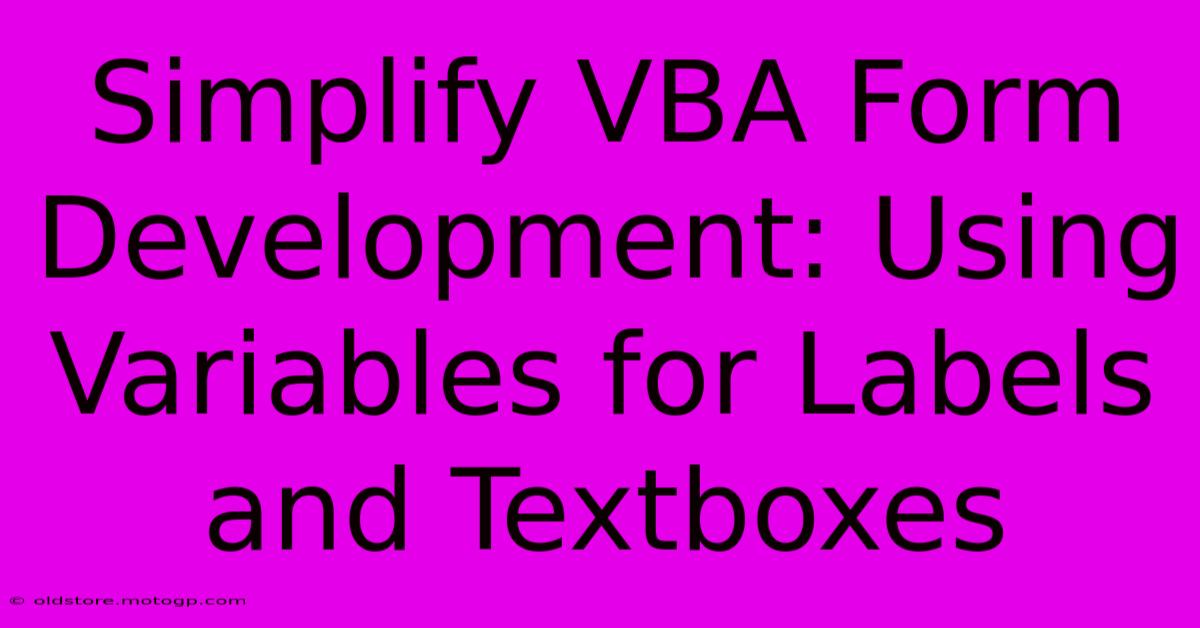Simplify VBA Form Development: Using Variables For Labels And Textboxes

Table of Contents
Simplify VBA Form Development: Using Variables for Labels and Textboxes
Developing user forms in VBA can sometimes feel like navigating a maze. Keeping track of numerous controls, especially when dealing with many text boxes and labels, can lead to cumbersome and difficult-to-maintain code. This article shows you how to significantly simplify your VBA form development by utilizing variables to manage your labels and textboxes. This technique enhances code readability, makes updates easier, and ultimately saves you time and frustration.
The Problem with Direct References
Let's say you're building a data entry form with ten fields. Without using variables, you might end up with code like this:
Me.Label1.Caption = "Name:"
Me.TextBox1.Value = ""
Me.Label2.Caption = "Address:"
Me.TextBox2.Value = ""
' ...and so on for eight more fields...
This approach is repetitive, prone to errors (especially if you need to rearrange controls), and makes modifications a nightmare. Imagine needing to change the caption of "Name:" to "Full Name:". You'd have to manually update it in multiple places.
The Power of Variables: A Cleaner Approach
By using variables, we can dramatically improve the code's clarity and maintainability. Here's how:
Dim lblName As MSForms.Label
Dim txtName As MSForms.TextBox
' ... Declare variables for other controls
Set lblName = Me.Label1
Set txtName = Me.TextBox1
lblName.Caption = "Full Name:"
txtName.Value = ""
' ...Similarly assign and use variables for other controls
This code is much more readable and easier to understand. Now, changing the caption of "Full Name:" only requires modification in one place.
Beyond Simple Assignment: Dynamic Control Management
The real power of this approach comes when you combine it with loops and arrays. Imagine a form with many similar fields. Instead of declaring each label and textbox individually, you can use arrays:
Dim lblFields(1 To 10) As MSForms.Label
Dim txtFields(1 To 10) As MSForms.TextBox
Dim i As Integer
For i = 1 To 10
Set lblFields(i) = Me.Controls("Label" & i)
Set txtFields(i) = Me.Controls("TextBox" & i)
lblFields(i).Caption = "Field " & i & ":"
Next i
This code dynamically assigns variables to your controls based on their names. This is particularly helpful if you generate forms programmatically or have a large number of similar fields.
Best Practices and Considerations
-
Descriptive Variable Names: Use clear and descriptive names for your variables (e.g.,
lblCustomerName,txtOrderNumber). This significantly improves code readability. -
Error Handling: Always include error handling (e.g.,
On Error Resume Next) when working with controls to gracefully handle situations where a control might not exist. -
Control Naming Conventions: Establish a consistent naming convention for your controls (e.g.,
lblfor labels,txtfor text boxes,cmdfor command buttons). This makes it easier to manage and identify controls within your code. -
Data Validation: Remember to implement data validation within your forms. Using variables makes it easier to perform validation checks on user input in a structured and reusable manner.
Conclusion: Clean, Maintainable VBA Forms
Using variables for labels and textboxes in your VBA form development is a simple yet powerful technique. It significantly improves code readability, reduces errors, and makes your forms much easier to maintain and update. By incorporating best practices and employing techniques like arrays, you can unlock the full potential of this approach and streamline your VBA development workflow. Start using variables today and experience the difference!

Thank you for visiting our website wich cover about Simplify VBA Form Development: Using Variables For Labels And Textboxes. We hope the information provided has been useful to you. Feel free to contact us if you have any questions or need further assistance. See you next time and dont miss to bookmark.
Featured Posts
-
Maximize Your Investment Get More Bang For Your Monitor Bucks With Hdmi Splitter
Feb 06, 2025
-
Hack The System The Insiders Secret To Maximizing Wednesdays Email Marketing Magic
Feb 06, 2025
-
Face Forward Breaking Down The Expense Of Maxillofacial Surgeon Consultations
Feb 06, 2025
-
Sorry We Ll Say It Again We Ve Let You Down And We Re Here To Apologize
Feb 06, 2025
-
Transform Your Words Into Art The Ultimate Guide To Creating Custom Journals
Feb 06, 2025
